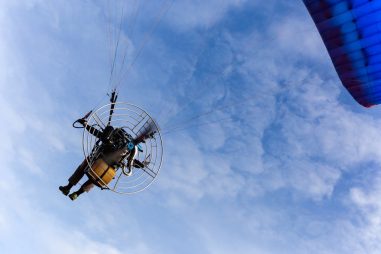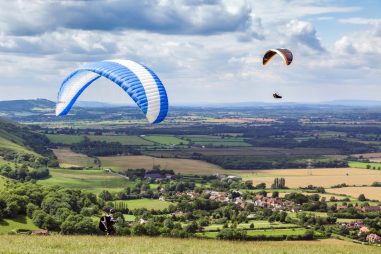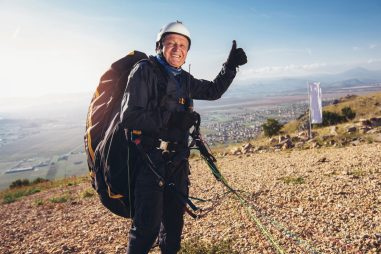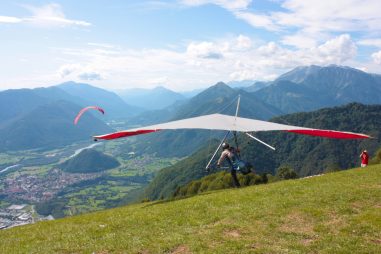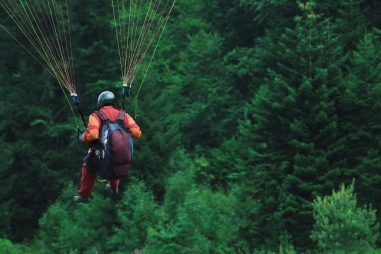Cross country paragliding mainly covers long distances. Soaring paragliding is making use of the rising air above the slope of the mountain to gain elevation. On the other hand, thermal flying is gaining altitude through bubbles of rising air.
What Is Cross Country Paragliding?
Cross country paragliding is a branch of paragliding where you travel great distances. You are heavily reliant on two things, the sun and the wind. So it combines not only your flying experience but as well as your backpacking skills.
Cross country paragliding requires expertise in thermalling and elite knowledge of air conditions. In addition, you must know flying regulations in each area you visit and have exemplified delivering good judgment throughout your flying time with little to no accidents.
How Do You Fly Paragliding in XC?
Similar to takeoff on traditional paragliding, you perform a foot launch to begin the ascent. You will constantly rely on weather conditions to do cross country (XC) paragliding. There are four essential skills that will separate cross country from other types of paragliding and will help you be successful.
- Thermalling: Thermals will help you ascend and travel farther distances. Outstanding knowledge of where to locate thermals and how to go through them is essential in cross country paragliding. Professional pilots use a variometer to find rising or sinking air. Some also rely on birds and clouds.
- Knowledge of overall weather conditions: Consistent monitoring of air conditions is crucial. Air conditions will frequently change throughout the flight, and it will help if you can quickly identify when there is a cloud development or a change in wind speed and air pressure. Otherwise, it may lead to a situation that is out of your control.
- Backpacking skills: There is only so much you can take with you in cross country paragliding because the weight will affect your overall performance. Carry all the gear you will need with you to endure the trip.
- Executing good judgment: Nothing could be more important than this. It is a result of years of experience, superior knowledge of weather, and following rules and regulations. Remember, most accidents are due to a pilot’s inability to make a wise decision when in an emergency.
You will need a flight plan before attempting to do cross country paragliding. It will allow you to study the flight path and the weather conditions around the area and find sites where you can rest. Most importantly, someone else should be aware of your plans in case of an emergency.
Is Cross Country Paragliding Safe?
Yes, cross country paragliding is safe. However, it requires years of experience and expert knowledge of meteorology and weather development. Also, you will be in areas where it is impossible to access by foot and zones not feasible for landing. The view above is breathtaking, but it has its risks.
Here are some ways you can cross country paraglide safely:
- Flight plan: Studying your flight path is crucial. It involves an assessment of the site and the weather. Where to launch, fly, and land are all included in this.
- Solid foundational knowledge and skills: Knowledge and experience are power. You must have an excellent understanding of meteorology. You must also be highly skilled in paragliding, with little to no accidents.
- Focus: Be free from distractions and maintain your focus on what you need to do and where you need to go.
- Use of correct paragliding equipment: You may need a different type of wing for cross country paragliding. Choose one that is efficient and will make you feel comfortable the most.
- Be with a friend: It is inadvisable to cross country paraglide on your own. Someone must be on the ground monitoring your progress and is also aware of your flight path. It is especially helpful in the event of an emergency.
You can make cross country paragliding an even more incredible experience by making it safe for you and others. Your safety will hugely depend on your approach to paragliding.
What Is Soaring in Paragliding?
Soaring in paragliding is gaining altitude by using the rising air above the slope of the mountain. It is a result of wind blowing over that is deflected upwards, creating a zone of rising air. It is an advanced way of gaining altitude without a great deal of dependence on thermals.
The lift strength will hugely depend on the slope profile and the wind speed. Ideally, the best soaring is when the wind is 90 degrees to the hill, and the shape of the ridge is without any variance, with low wind speed. However, this is seldom the case, making it an advanced technique and recommended only for skilled pilots.
How Do You Ridge Soar in Paragliding?
You will first need to identify the wind direction and assess the ridge profile before attempting to soar. Once you do, you’ll only need to follow the mountain ridge and climb into the rising flow. However, it can be dangerous, so here are a few things to note.
- Don’t fight the wing: Once you are in the rising flow, the canopy will automatically pull you up. If you fight back, it will generate too much power, which can be detrimental.
- Develop your control skills: You want to maximize the energy you will gain going through the rising air, and how you turn and maneuver your glider is a crucial factor in this. The more turns, the less energy is left.
- Get away from strong winds around the terrain: It will add to your wind strength, which can lead to a situation out of your control. Avoid flying in these areas.
Ridge soaring is an advanced technique and is recommended only for highly experienced pilots. It is usually combined with thermal flying to maximize the speed and distance traveled.
What Is a Thermal in Paragliding?
Thermal in paragliding is gaining altitude through bubbles of rising air. They are most common in the mountains, but they are invisible. It is crucial in paragliding because, in a way, it is your fuel. Without it, you will not be able to cover farther distances.
Thermalling is a fundamental skill that allows you to climb and soar efficiently. Perfecting this skill will give you an advantage in any type of paragliding.
How to Find Thermals for Paragliding
Thermals are invisible, but there are various factors that will help you locate them. Thankfully, there is an instrument you can use to know if you are in a thermal, which is called a variometer. When it starts beeping, you know you are gaining altitude and potentially near or in a thermal. Here are a few more clues to help you locate thermals.
- Sun: If it’s bright and clear, it is highly likely that there are thermals. Without the sun, there is a low chance of getting an ideal thermal source.
- Wind and landscape: Of course, there are no thermals without the wind blowing through hillsides and mountains. You will be able to locate where rising air might be by studying the shape of the terrain.
- Clouds: Look for cumulus clouds. They are only formed by rising air, so it is a giveaway that a thermal is present there.
- Birds: When you look up or around you and see birds circling around an area, there is a thermal present.
Locating a thermal is a foundational skill that is hugely beneficial in paragliding. The power of a thermal lift is incredible and one that will give you an advantage in any type of paragliding.
How to Thermal Better in Paragliding
Once you locate a thermal, you’ll want to start circling around, otherwise known as the 360-degree turn. It is the most basic thermalling technique and helpful when going through narrow thermals. The best way is always to turn around the core where you feel the lift is strongest. Your variometer will help you locate this.
You can keep repeating this until you reach a height of your choice. You can then effortlessly get out of the thermal after a final turn.



